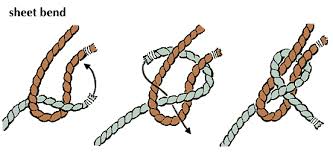Know your Knots

There’s an old saying, “If you can’t tie a knot, tie a lot”. I’m sure you’ve seen all too often a nice rig on the trail with a spider web of unsightly knots securing gear to the roof rack. Knot tying is one of the most over looked skill sets in my opinion. It’s not as attractive as building fires or catching fish but it’s useful in camping, survival, and even more so in everyday life.
Look at knots as though they are tools. Different knots have their own properties that make them better suited for certain tasks. Another good point is to use cordage with ample strength for the job, because knots will reduce the ropes breaking strength
Knots can become difficult to remember. It’s best to master a few then move on to more complex knots. I will be covering two basic knots that are useful in a variety of situations.
BOWLINE KNOT
This is probably one of the most important knots to learn. It’s required learning in the Boy Scouts, Sailing Certifications, and to become a Navy SEAL (where you have to tie it underwater while holding your breath). Another benefit is its strength and that it can easily be untied.
USE: to create a fixed loop at the end of a line or to anchor a line to a fixed object.
Bowline Knot Directions

- Make a loop
- Pass the tail through it
- Bring the tail around the backside of the standing line
- Wrap behind standing line
- Run the tail end back through the first loop
- Tighten and dress knot down
SHEET BEND
At times you will need to join two lines together when needing a longer length of rope. There are many knots that can accomplish this but the sheet bend allows you to fasten two ropes of different diameter and is quick to untie.
USE: joining two ropes even if they vary in thickness
Sheet Bend Directions

- Make a loop in one rope (use the thicker of the two if joining two different diameter ropes).
- Place the other rope through the loop when crossing behind both the standing and working end of the main rope.
- Now slide the rope underneath itself and tighten forming the knot.
CORDAGE SELECTION
For survival and outdoor activities you should have a good selection of cordage in your kit. I’ve used many different types but always resort back to 550 cord. My old Sergeant used to say that 550 cord and duct tape will fix anything (and I agree). It is also called “paracord” due to its original use as suspension lines of parachutes. The military realized how useful it was in field craft and it eventually carried over to the civilian market. It is comprised of an outer case with 7 inner strands that can be taken out for when finer string is needed (for survival fishing or sewing).
